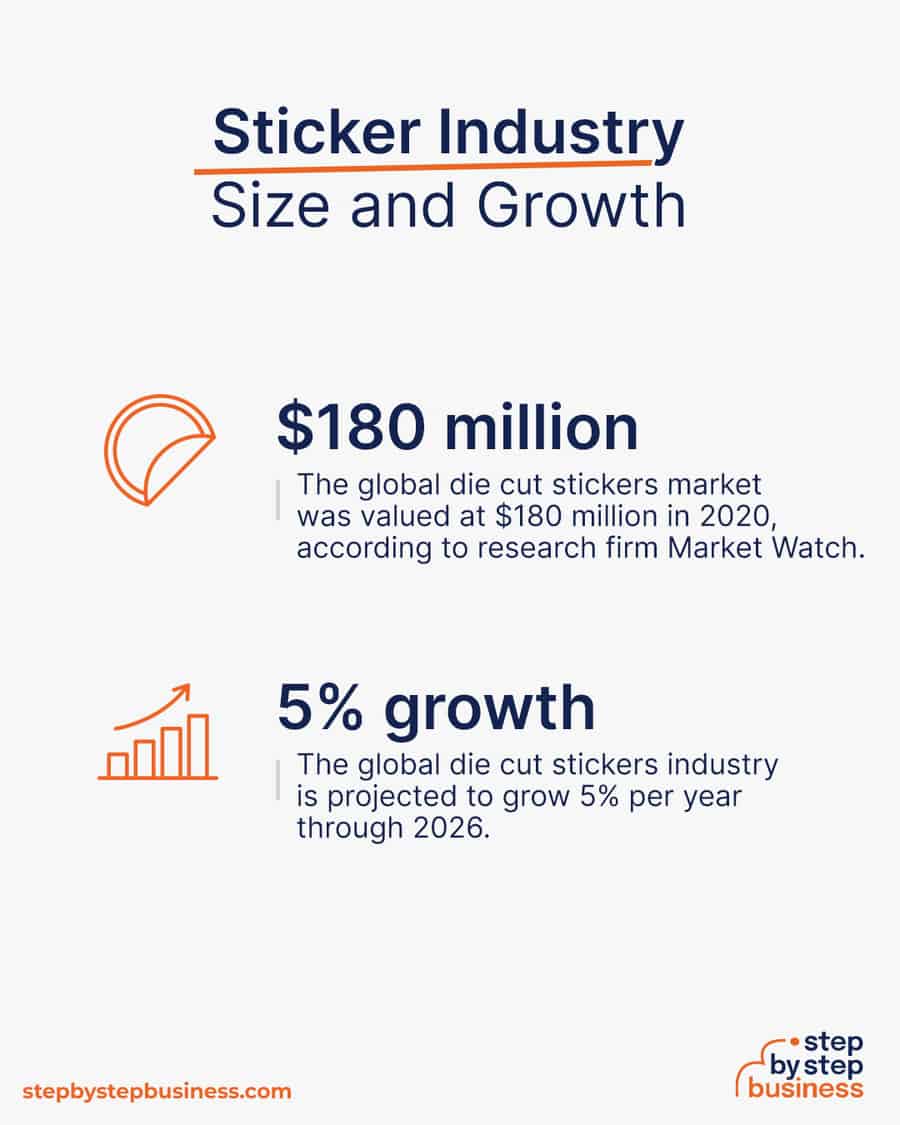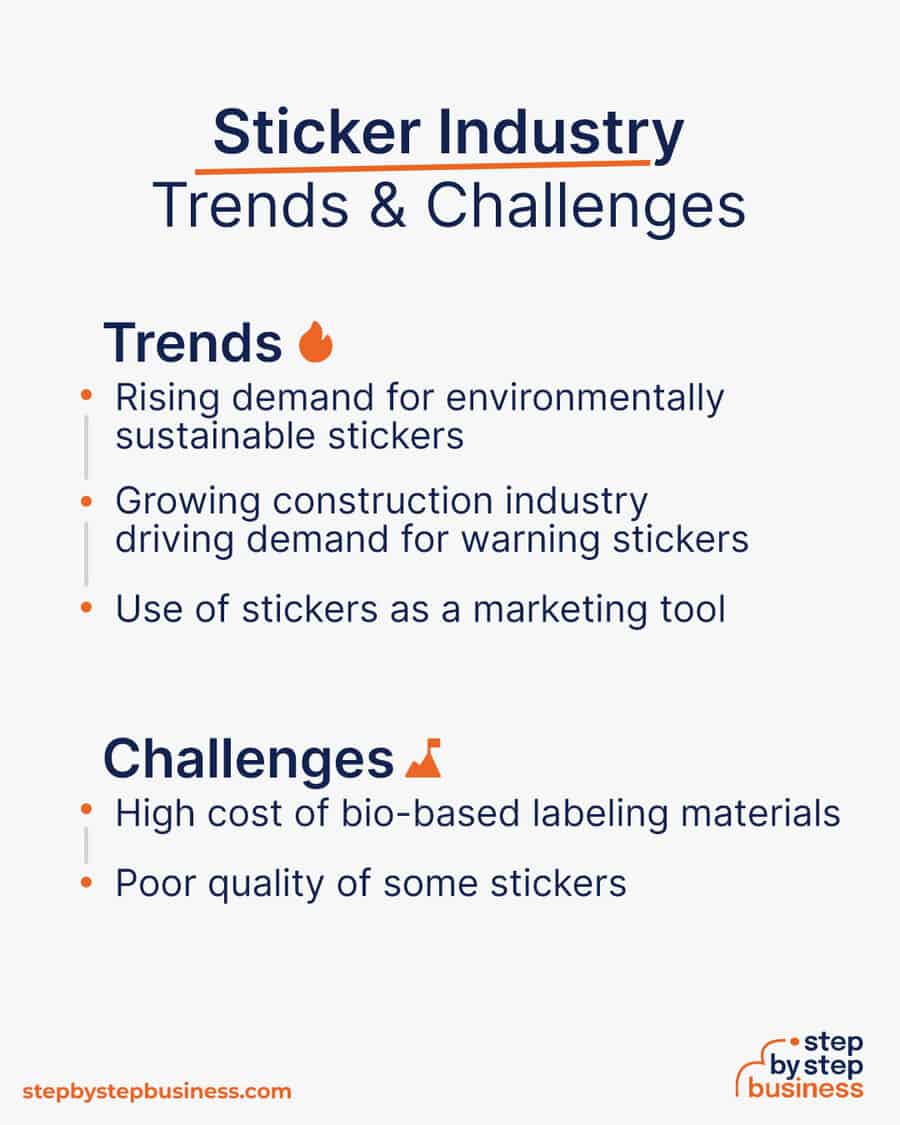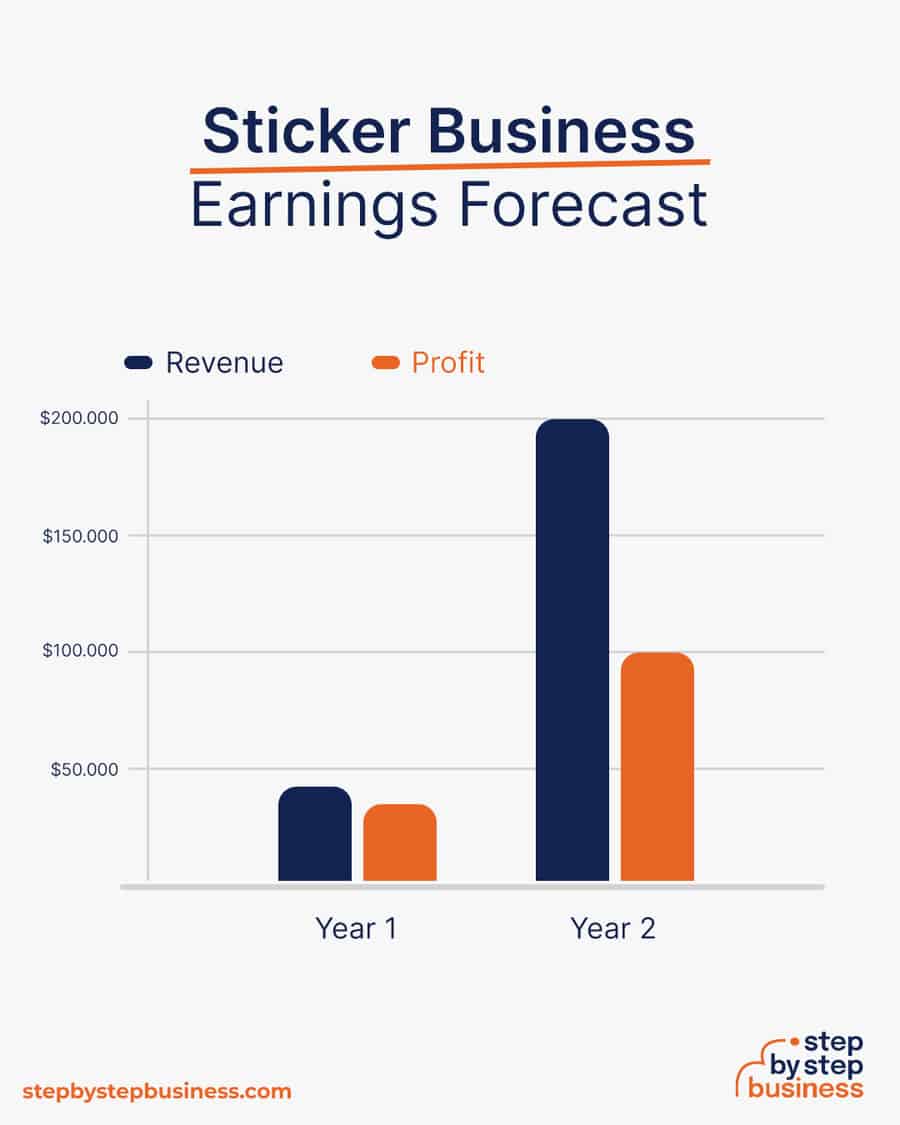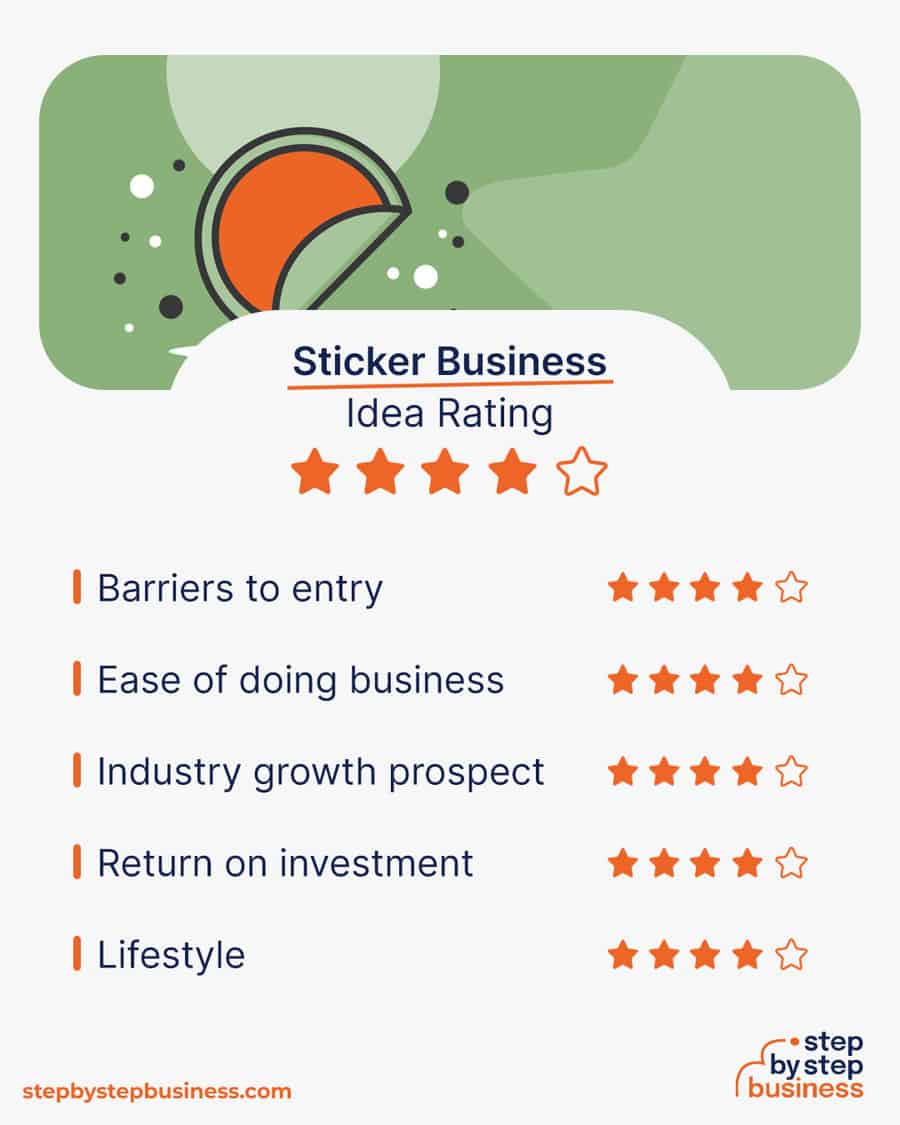Find aDomain Search Powered byGoDaddy.com ...
In a competitive landscape, stickers are a cost-effective, alternative marketing tool that seize the attention of the target audience and help companies improve their branding and promotions.
We earn commissions if you shop through the links below. Read more
Written by: Esther Strauss
Published on August 18, 2021
Updated on November 28, 2022

Investment range
$5,000 - $27,000
Revenue potential
$40,000 - $200,000 p.a.
Time to build
0–3 months
Profit potential
$34,000 - $100,000 p.a.
Industry trend
Growing
Commitment
Flexible
While the world embraces digital initiatives and the virtual life, there’s still no denying the value of something you can see and touch in the real world. That’s why stickers are still gaining popularity—they’re a great way for a company to get their branding out there at little cost.
If you’re looking to start a sticker business and take advantage of growing demand from business clients, it’s best to start with the fundamentals. This step-by-step guide lays out everything you need to know to develop and launch a successful sticker business. Don’t just get stuck on an idea—get to work and let your business soar!

You need to know the big picture if you want a good start with your sticker business.
A sticker business can be very rewarding, but also has its downsides. We’ve made a list to help you weigh the risks against the potential rewards.
Stickers are hot right now. Market analyst Industry Research values the global die-cut stickers market at nearly $190 billion and expects sharp 5.2% annual growth through 2027 as economies rebound. North America holds the largest share of that global market, at nearly a third, while the Chinese market is fast gaining ground.
Many of the world’s leading brands, including Calvin Klein, Coach, and Stussy, have had recent sticker campaigns. Some of the latest trends from industry leaders like StickerYou and StandoutStickers include stickers that promote a certain destination or a way of life, such as visiting Las Vegas or being more eco-friendly.

Trends shaping the sticker industry include:
Challenges in the sticker industry include:

Start-up costs for a sticker business range from $5,000 to $27,000 or more, with an average of $16,000. At the minimum budget, it’s assumed you’ll operate from home while outsourcing production, eliminating the need for printing equipment. The maximum budget includes setting up a physical storefront with in-house printing.
Inventory is one of the major start-up costs under both minimum and maximum budgets. This represents the cost of procuring raw material for stickers, as well as a finished stock of general stickers that are up for sale.
| Start-up Costs | Ballpark Range | Average |
|---|---|---|
| Licenses and permits | $100 - $300 | $200 |
| Insurance | $100 - $300 | $200 |
| Marketing and advertising | $1,000 - $3,000 | $2,000 |
| Website | $500 - $1,000 | $750 |
| IT equipment and software | $1,400 - $2,800 | $2,100 |
| Digital printer and potter | $0 - $10,000 | $5,000 |
| Inventory | $1,500 - $4,500 | $3,000 |
| Storefront setup | $0 - $4,000 | $2,000 |
| Miscellaneous | $400 - $1,100 | $750 |
| Total | $5,000 - $27,000 | $16,000 |
In the first phase, you should consider outsourcing production to ease the burden on you. This will allow you to exclusively focus on business development and sales generation.
John Fischer, founder of StickerGiant, says his company reached $3 million in annual revenue before buying their first piece of printing equipment. They continued to outsource printing until their sales became consistently predictable to warrant the investment.
Once you go that route, you’ll need a digital printer and plotter begin in-house production. You may also need a commercial press if your business expands and you want to extend your production capacity. Digital printers and plotters start at $10,000, while commercial presses start at $100,000.
Your potential revenue depends on your prices and quantity of sales. Keep in mind, retail prices will be higher than wholesale prices. The average per-unit retail price of a small sheet of stickers is $3.36.
According to MakeStickers, the cost of producing a single sticker sheet averages out to $.50, based on an order of 1,000 stickers.((https://www.makestickers.com/wholesale-bumper-stickers.aspx)) Gross profit is therefore $2.87 per unit, resulting in an 85% margin.
If you’re just starting out as a solopreneur, you should be able to sell 1,000 small sheets per month, giving you annual revenue of just over $40,000 and profit of more than $34,000. As you build your brand, you may be able to achieve 5,000 monthly sticker sales a month. But at this level you’d need staff and an office, which drop your margin to 50%.
As a result, you’d have annual revenue of just over $200,000, and more than $100,000 in profit. This could be easily scaled up to 10,000 monthly unit sales or more, which means the revenue potential of a sticker company is almost unlimited.
US industry leader Sticker Giant, for instance, counts Apple, Google and NASA among its clients, and takes in about $21 million in annual revenue.

There are few major barriers to entry. The competition may be intense, but it is offset by a huge demand. Other barriers to entry include no switching cost for clients and certain skill-set requirements for the entrepreneur.
You also need to appraise yourself to find out whether you have the right skills to launch and run a sticker business.
If you are a solopreneur, having advanced-level drawing skills is a must. Even if you intend to hire a designer, you should have basic knowledge of graphic design apps like Canva, Procreate, Apple Keynote, and PicMonkey.
You should also be fluent in writing, and ideally have basic- to intermediate-level knowledge of finance and marketing. Some other soft skills that you should possess include creative thinking, leadership, visualizing, management and team-building.
If you need professional training, you can check out specialized sticker making courses online, like those offered by Digital Planner Academy. You also have the option of free learning methods, such as watching tutorials on YouTube.

With your initial research done and the plan nearly finalized, you should drill down and hone your idea by figuring out the why, what, and who of your sticker business.
In a competitive landscape, companies need to differentiate themselves from rivals to stand out. To find an opportunity, research which stickers are popular in your area, given that you’re likely to begin from the local market before growing to the national or international level.
You should also choose which medium you want to focus on: digital stickers, physical stickers, or both.
Digital stickers are gaining popularity and present opportunities to new entrants. For instance, in 2016 the messaging app Line sold $268 million worth of digital stickers.[3] Underestimate the profit potential of stickers at your own risk.
In a competitive landscape, stickers are a cost-effective, alternative marketing tool that seize the attention of the target audience and help companies improve their branding and promotions.
There are two types of stickers: general stickers and custom stickers.
You can sell either type of sticker in digital and tangible forms. There are different sales strategies associated with both types, which we’ll discuss in more detail at the end of the article.
The types of material used in sticker manufacturing depend on how and where it will be used. For example, industrial vinyl is best suited for outdoor use.
The following is a list of popular materials used stickers:
Laminations are also used to increase sticker durability and protection. The main types are:
Stickers come in various cuts and formats. The most common are:
Stickers can be used for various purposes. The main sticker types are:
The retail price of a sticker varies from $2 to $6 on Etsy. According to MakeSticker, the retail price of stickers varies from $4.95 to $9.95. Based on these two sources, the average retail price is about $6.
The wholesale price will of course be different as it is subject to volume-based discounts. For example, Sticker Giant charges an average of $93.11 for 125 stickers, while its per-sticker price is about $0.74.
Based on the above, you should expect your per-unit price across retail and wholesale clients to average about $3.36. Once you know your costs, you can use this Step By Step profit margin calculator to determine your mark-up and final price points. Remember, the prices you use at launch should be subject to change if warranted by the market.
The target market for a sticker business is broad and mostly B2B (business to business) focused, meaning your customers will likely be other companies. Businesses need stickers for branding and promotion purposes, and to label their products.
However, you cannot target the entire corporate sector at once. You need to carry out market research and discover potential target market opportunities around you. Focus on one industry at a time, gain expertise in that niche, and then if you succeed in that area, target another market segment.
Initially, you can start with a home-based office and gradually grow to a physical storefront. If you’re taking on printing and cutting jobs in-house, you need a relatively large commercial space.
Find commercial space to rent in your area on Craigslist, Crexi, and Commercial Cafe. When choosing a commercial space, you may want to follow these rules of thumb:


Your business name is your business identity, so choose one that encapsulates your objectives, services, and mission in just a few words. You probably want a name that’s short and easy to remember, since much of your business, and your initial business in particular, will come from word-of-mouth referrals.
Here are some ideas for brainstorming your business name:
Once you’ve got a list of potential names, visit the website of the US Patent and Trademark Office to make sure they are available for registration and check the availability of related domain names using our Domain Name Search tool. Using “.com” or “.org” sharply increases credibility, so it’s best to focus on these.
Finally, make your choice among the names that pass this screening and go ahead with domain registration and social media account creation. Your business name is one of the key differentiators that sets your business apart. Once you pick your company name, and start with the branding, it is hard to change the business name. Therefore, it’s important to carefully consider your choice before you start a business entity.
Every business needs a plan. This will function as a guidebook to take your startup through the launch process and maintain focus on your key goals. A business plan also enables potential partners and investors to better understand your company and its vision:
If you’ve never created a business plan, it can be an intimidating task. You might consider hiring a business plan specialist at Fiverr to create a top-notch business plan for you.

Registering your business is an absolutely crucial step — it’s the prerequisite to paying taxes, raising capital, opening a bank account, and other guideposts on the road to getting a business up and running.
Plus, registration is exciting because it makes the entire process official. Once it’s complete, you’ll have your own business!
Your business location is important because it can affect taxes, legal requirements, and revenue. Most people will register their business in the state where they live, but if you are planning to expand, you might consider looking elsewhere, as some states could offer real advantages when it comes to stickers.
If you’re willing to move, you could really maximize your business! Keep in mind, it’s relatively easy to transfer your business to another state.
Business entities come in several varieties, each with its pros and cons. The legal structure you choose for your sticker business will shape your taxes, personal liability, and business registration requirements, so choose wisely.
Here are the main options:
We recommend that new business owners choose LLC as it offers liability protection and pass-through taxation while being simpler to form than a corporation. You can form an LLC in as little as five minutes using ZenBusiness’s online LLC formation service. They will check that your business name is available before filing, submit your articles of organization, and answer any questions you might have.

The final step before you’re able to pay taxes is getting an Employer Identification Number, or EIN. You can file for your EIN online or by mail or fax: visit the IRS website to learn more. Keep in mind, if you’ve chosen to be a sole proprietorship you can simply use your social security number as your EIN.
Once you have your EIN, you’ll need to choose your tax year. Financially speaking, your business will operate in a calendar year (January–December) or a fiscal year, a 12-month period that can start in any month. This will determine your tax cycle, while your business structure will determine which taxes you’ll pay.
The IRS website also offers a tax-payers checklist, and taxes can be filed online.
It is important to consult an accountant or other professional to help you with your taxes to ensure you are completing them correctly.
Securing financing is your next step and there are plenty of ways to raise capital:
Bank and SBA loans are probably the best option, other than friends and family, for funding a sticker business. You might also try crowdfunding if you have an innovative concept.


Starting a sticker business requires obtaining a number of licenses and permits from local, state, and federal governments.
Federal regulations, licenses, and permits associated with starting your business include doing business as (DBA), health licenses and permits from the Occupational Safety and Health Administration (OSHA), trademarks, copyrights, patents, and other intellectual properties, as well as industry-specific licenses and permits.
You may also need state-level and local county or city-based licenses and permits. The license requirements and how to obtain them vary, so check the websites of your state, city, and county governments or contact the appropriate person to learn more.
You could also check this SBA guide for your state’s requirements, but we recommend using MyCorporation’s Business License Compliance Package. They will research the exact forms you need for your business and state and provide them to ensure you’re fully compliant.
This is not a step to be taken lightly, as failing to comply with legal requirements can result in hefty penalties.
If you feel overwhelmed by this step or don’t know how to begin, it might be a good idea to hire a professional to help you check all the legal boxes.
Before you start making money you’ll need a place to keep it, and that requires opening a bank account.
Keeping your business finances separate from your personal account makes it easy to file taxes and track your company’s income, so it’s worth doing even if you’re running your sticker business as a sole proprietorship. Opening a business bank account is quite simple, and similar to opening a personal one. Most major banks offer accounts tailored for businesses — just inquire at your preferred bank to learn about their rates and features.
Banks vary in terms of offerings, so it’s a good idea to examine your options and select the best plan for you. Once you choose your bank, bring in your EIN (or Social Security Number if you decide on a sole proprietorship), articles of incorporation, and other legal documents and open your new account.
Business insurance is an area that often gets overlooked yet it can be vital to your success as an entrepreneur. Insurance protects you from unexpected events that can have a devastating impact on your business.
Here are some types of insurance to consider:


As opening day nears, prepare for launch by reviewing and improving some key elements of your business.
Being an entrepreneur often means wearing many hats, from marketing to sales to accounting, which can be overwhelming. Fortunately, many websites and digital tools are available to help simplify many business tasks.
You could use graphic design apps like Canva, Procreate, Apple Keynote, and PicMonkey to improve layouts, design, and presentation.
Some of your business will come from online visitors, but you should still invest in digital marketing! Getting the word out is especially important for new businesses, as it’ll boost customer and brand awareness.
Once your website is up and running, link it to your social media accounts and vice versa. Social media is a great tool for promoting your business because you can create engaging posts that advertise your products:
Take advantage of your website, social media presence and real-life activities to increase awareness of your offerings and build your brand. Some suggestions include:
Website development is crucial because your site is your online presence and needs to convince prospective clients of your expertise and professionalism. They are unlikely to find your website, however, unless you follow Search Engine Optimization (SEO) practices. These are steps that help pages rank higher in the results of top search engines like Google.
You can create your own website using services like WordPress, Wix, or Squarespace. This route is very affordable, but figuring out how to build a website can be time-consuming. If you lack tech-savvy, you can hire a web designer or developer to create a custom website for your business.
Unique selling propositions, or USPs, are the characteristics of a product or service that sets it apart from the competition. Customers today are inundated with buying options, so you’ll have a real advantage if they are able to quickly grasp how your stickers meet their needs or wishes. It’s wise to do all you can to ensure your USPs stand out on your website and in your marketing and promotional materials, stimulating buyer desire.
Global pizza chain Domino’s is renowned for its USP: “Hot pizza in 30 minutes or less, guaranteed.” Signature USPs for your sticker business could be:

You may not like to network or use personal connections for business gain. But your personal and professional networks likely offer considerable untapped business potential. Maybe that Facebook friend you met in college is now running a sticker business, or a LinkedIn contact of yours is connected to dozens of potential clients. Maybe your cousin or neighbor has been working in sticker production for years and can offer invaluable insight and industry connections.
The possibilities are endless, so it’s a good idea to review your personal and professional networks and reach out to those with possible links to or interest in stickers. You’ll probably generate new customers or find companies with which you could establish a partnership. Online businesses might also consider affiliate marketing as a way to build relationships with potential partners and boost business.

If you’re starting out small from a home office, you may not need any employees. But as your business grows, you will likely need workers to fill various roles. Potential positions for a sticker business include:
At some point, you may need to hire all of these positions or simply a few, depending on the size and needs of your business. You might also hire multiple workers for a single role or a single worker for multiple roles, again depending on need.
Free-of-charge methods to recruit employees include posting ads on popular platforms such as LinkedIn, Facebook, or Jobs.com. You might also consider a premium recruitment option, such as advertising on Indeed, Glassdoor, or ZipRecruiter. Further, if you have the resources, you could consider hiring a recruitment agency to help you find talent.

Stickers will probably never get old. They’re almost always a part of any fandom merchandise, be it anime, gaming, music, or movies and TV. They’re often used as marketing tools, along with those timeless brochures and flyers. Stickers are also used in a wide range of applications, such as backsplash stickers in the kitchen or car decals.
So, opening a sticker business in a highly competitive market could be the best decision you’ve ever made. With a lot of creativity and aggressive marketing, you’re now ready to start your entrepreneurial journey and make money out of your sticker business!
Stickers can be extremely profitable. With profit margins of up to 85%, you can earn a significant amount by buying stickers at wholesale prices and selling them at retail prices, or by printing your own.
If you are creative and have a knack for sales, starting a sticker business can be very worthwhile. But you should know that sticker business is not a get-rich-quick scheme. It requires a lot of dedication and hard work to establish and grow a sticker business.
It only takes around $5,000 to set up a sticker business from home if your production operations are outsourced to a printing company. The start-up capital requirements will continue to mount as you continue to add more costs, e.g. buying a printer, hiring staff, and setting up a storefront.
Yes, you can certainly make money with a sticker business. You can earn anywhere from $30,000 to over $200,000 a year with a sticker business, depending on the volume of orders you receive and the size of your operations.
There are many factors that you should consider while pricing your product. First, you need to understand additional costs that are associated with selling stickers online, including shipping, packaging, product returns and marketplace commissions.
Secondly, the material and size of the sticker is another factor that will influence the price. Finally, you should also consider the type of client (e.g. wholesale or retail) while setting a suitable price.
Normally, stickers are priced in the range of $2 to $9.95 for retail customers. The wholesale price varies between $0.72 and $0.77.

Published on August 16, 2023
Find aDomain Search Powered byGoDaddy.com ...
Read Now

Published on March 16, 2023
Lorem ipsum dolor sit amet, consectetur adipiscing elit, sed do eiusmod tempor incididunt ut labore et dolore magna aliqua. Ut enim ad minim veniam, ...
Read Now

Published on March 10, 2023
When to Use Paychex Flex When to Use QuickBooks Payroll ...
Read Now
No thanks, I don't want to stay up to date on industry trends and news.
Comments